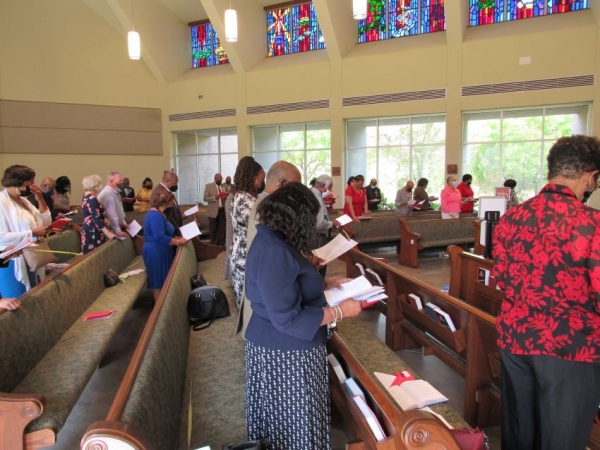What to Expect

You can expect to be warmly greeted when you arrive. We are an Episcopal Church, and our worship follows a liturgy (work of the people). The order for the service is outlined in the Book of Common Prayer, the red book found in the back of the pews. The page numbers will be printed in the bulletin you receive when entering the church and will be referenced by the letters BCP. We also use the 1982 Hymnal and the “Lift Every Voice and Sing” hymnal (LEVAS), also found in the back of the pews.
Eucharist
Holy Communion or the Eucharist (which literally means "thanksgiving") is the family meal for Christians and a foretaste of the heavenly banquet. All baptized persons are welcome to receive the bread and wine, and to be in communion with God and each other.
Bowing and Crossing
Before we enter or leave the pew of the church, some will bow before the altar. Some people genuflect or bend the knee. Both are gestures of reverence given to the cross and to the Altar where the sacrament or consecrated bread and wine representing the Body and Blood of Jesus are kept. Philippians 2:9-11 says, “Therefore God has highly exalted him and bestowed on him the name which is above every name, that at the name of Jesus every knee should bow, in heaven and on earth and under the earth, and every tongue confess that Jesus Christ is Lord, to the glory of God the Father.”
We also cross ourselves at times during the service by touching the forehead, heart, left shoulder and right shoulder. When we do, we are asking God to be “in our heads,” “in our hearts,” “and in all of me. Generally Episcopalians cross themselves whenever the priest blesses them, or at the words, “In the name of the Father, and of the Son, and of the Holy Spirit.” Paul writes, “For the word of the cross is folly to those who are perishing, but to us who are being saved it is the power of God.” (1 Corinthians 1:18)
Sharing Peace
After we hear the sermon, or having heard the Word of God proclaimed, having stated our basic beliefs in the Creed, and having confessed our sins to God, we express our desire to be at peace with God and each other by greeting one another. The exchange often begins with one person saying, “The peace of the Lord be with you,” and the other responding with, “And also with you.” The “Passing of the Peace,” as it is called, is based on the Kiss of Peace mentioned by the Apostle Paul in Romans 16:16. It also provides us with an opportunity to express our peace to one another before we engage in the Lord’s Supper, Communion, or Eucharist.